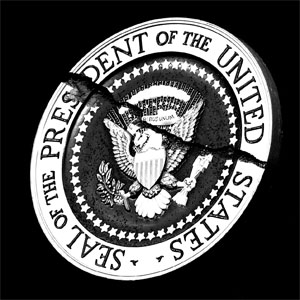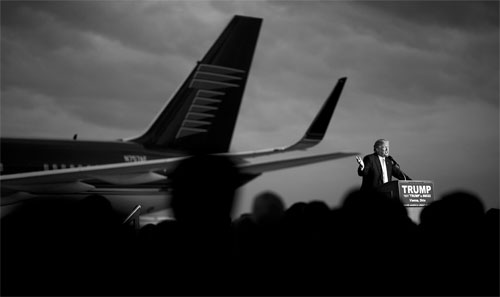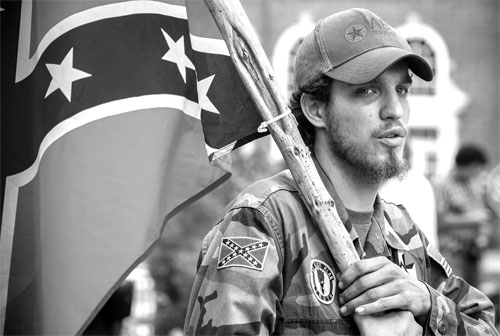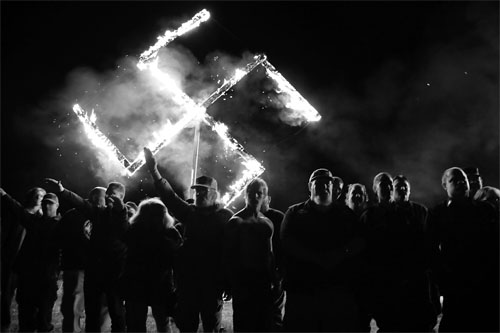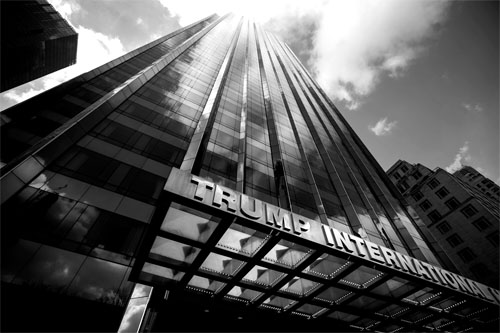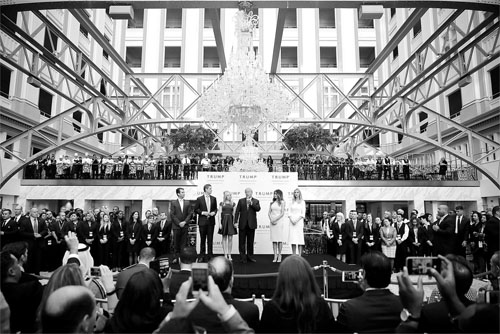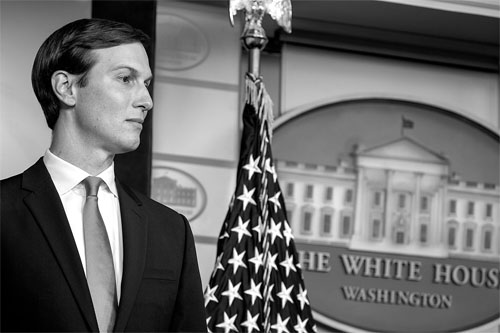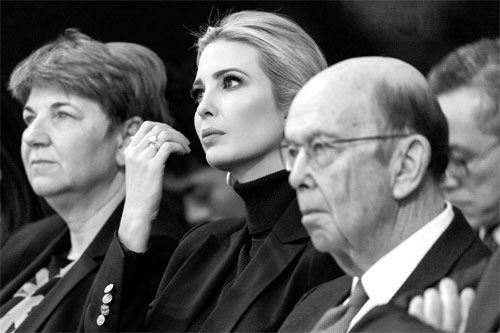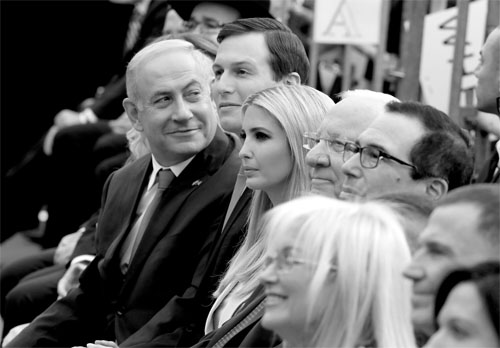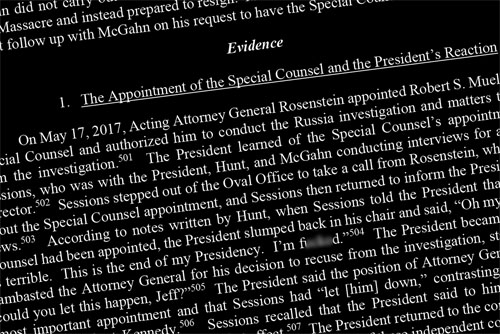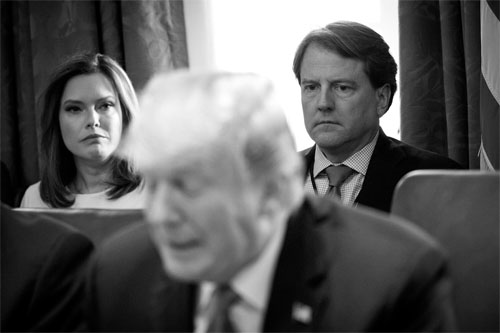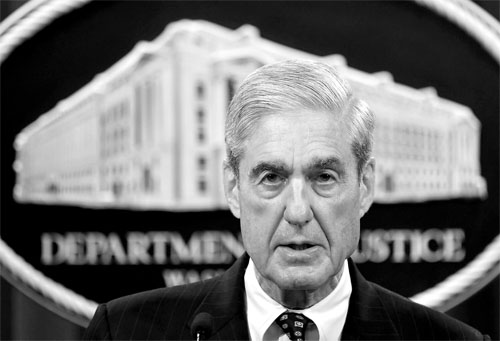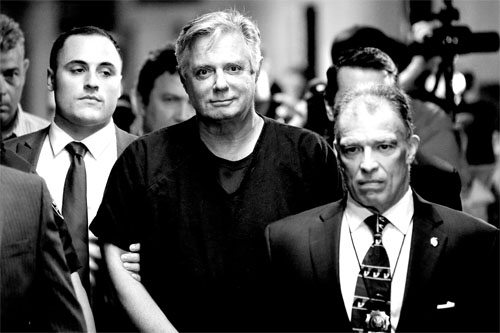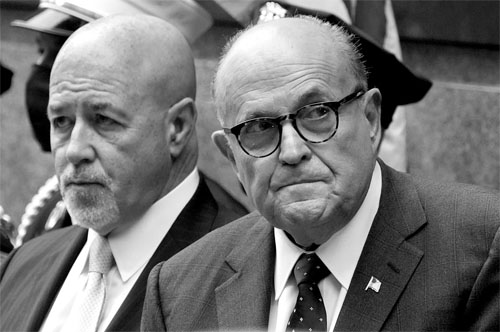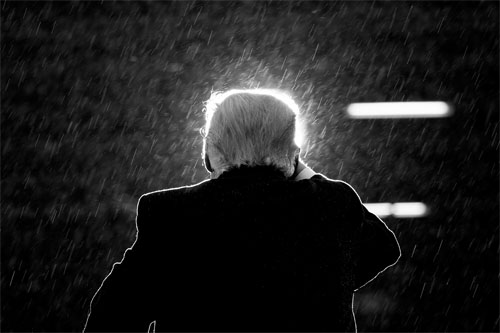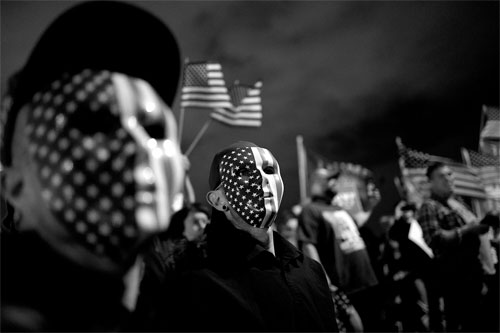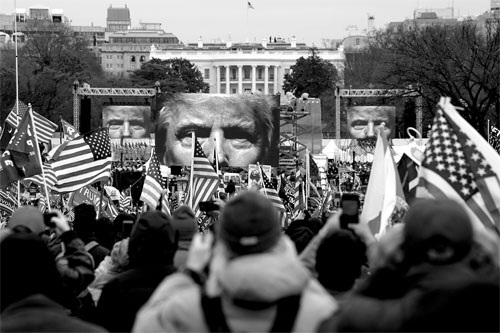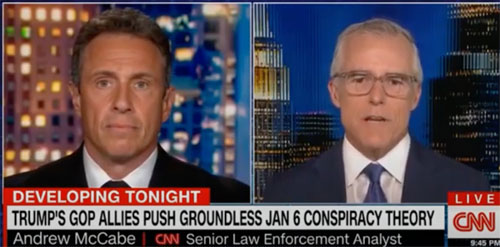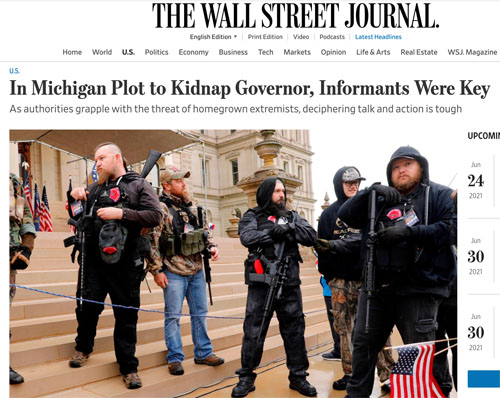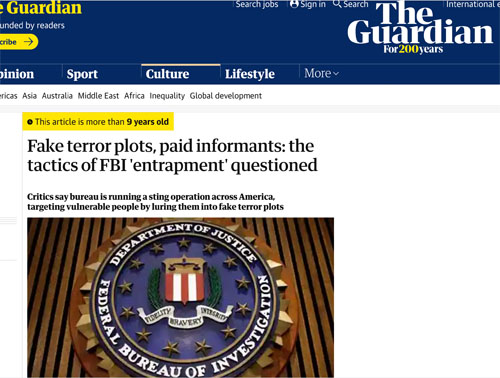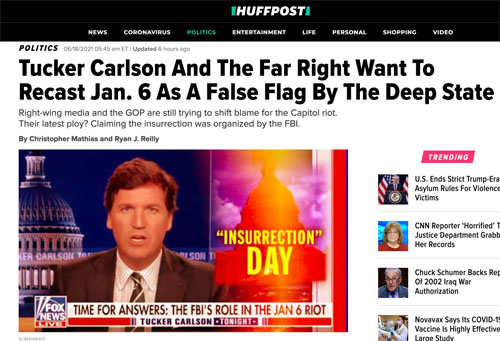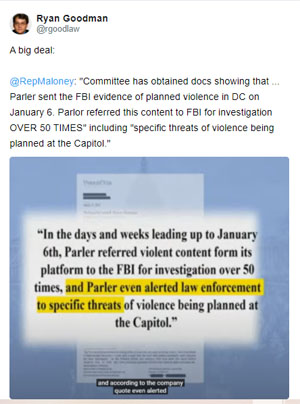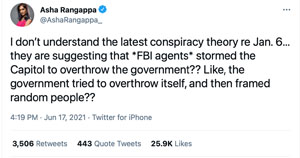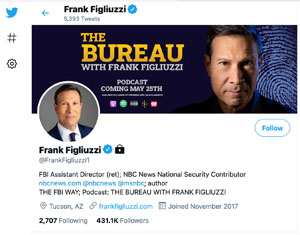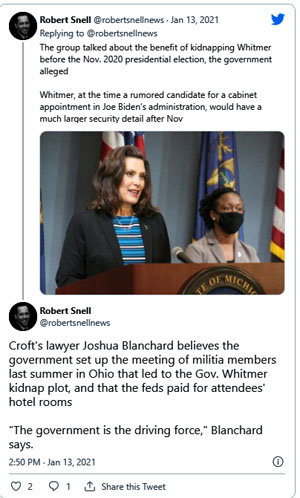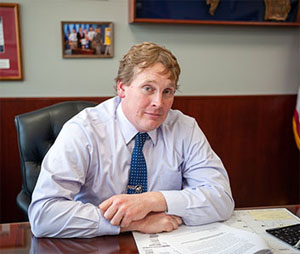by Judge Amy Berman Jackson
May 27, 2021
Document 25 Filed 05/27/21
UNITED STATES DISTRICT COURT
FOR THE DISTRICT OF COLUMBIA
Case 1:21-cr-00071-ABJ
Crim. Action No. 21-0071 (ABJ)
UNITED STATES OF AMERICA, v. KARL DRESCH, Defendant.
ORDER
Defendant has been indicted on five counts: (1) Obstruction of an Official Proceeding and Aiding and Abetting in violation of 18 U.S.C. §§ 1512(c)(2), 2; (2) Entering and Remaining in a Restricted Building or Grounds in violation of 18 U.S.C. § 1752(a)(1); (3) Disorderly and Disruptive Conduct in a Restricted Building or Grounds in violation of 18 U.S.C. § 1752(a)(2); (4) Disorderly Conduct in a Capitol Building in violation of 40 U.S.C. § 5104(e)(2)(D); and (5) Parading, Demonstrating, or Picketing in a Capitol Building in violation of 40 U.S.c. § 5104(e)(2)(G). Indictment [Dkt. # 5] at 1-3.
Defendant was arrested on January 19, 2021, see Rule 5(c)(3) Docs. [Dkt. # 7] at 1, and the government moved for pretrial detention pursuant to 18 U.S.C. § 3142(f)(2). Mot. for Detention [Dkt. # 23-1]. Defendant was ordered detained after a hearing before a Magistrate Judge in the Western District of Michigan on the grounds that the government had established that he posed a danger to the community and well as a risk of flight. Order of Detention Pending Trial [Dkt. # 18-6] at 2. The Magistrate Judge checked off boxes on the preprinted form to indicate that factors bearing on the decision included: "[the] Weight of the evidence is strong," "Prior criminal history," "History of violence or use of weapons," and "Prior attempt(s) to evade law enforcement." Id. at 2-3. The Magistrate Judge added:
In addition, the undersigned finds by clear and convincing evidence that no condition or combination of conditions of release will reasonably assure the safety of any other person and the community based on[:]
(1) Defendant's possession of firearms and ammunition following a felony conviction,
(2) Defendant's posting of statements reflecting a willingness to engage[] in additional actions that are similar to those he took on Jan. 6, 2021[,] and
(3) Defendant's willingness to flee pursuing police officers at high speed in 2013.
Id. at 3 (citations omitted).
On April 1, defendant filed a motion to "lift his preventive detention in this case." Mot. to Lift Preventive Detention and P. & A. in Supp. Thereof [Dkt. # 16] ("Mot.") at 1. In addition to making legal arguments, defendant has submitted numerous letters of support from members of his community. See Letters of Support [Dkt. # 16-1] ("Letters'').1 The government opposed the motion, Gov't Resp. to Mot. [Dkt. # 18] ("Opp."), and the Court held a hearing on the motion on May 3, 2021. Min. Entry (May 3, 2021). The issue has been fully briefed. See Def.'s Reply to Opp. [Dkt. # 20] ("Reply"). For the following reasons, the motion will be DENIED.
BACKGROUND
I. Defendant's Participation in the Attack on the United States Capitol
Defendant was arrested on January 19, 2021 after agents from the Federal Bureau of Investigation ("FBI") received a tip that he had posted information regarding his participation in the events now known as the Capitol Riots to his social media accounts. Statement of Facts [Dkt. # 1-1] ("SOF") , ¶ 11. Shortly thereafter, a search warrant was issued for additional information associated with defendant's Facebook account. Id. ¶ 12. The search revealed the following:
• On November 23,2020, defendant posted: "It's war everywhere if we let this election get stolen." Ex. 6 to Opp. [Dkt. # 18-7].
• On December 16,2020, defendant posted: "Stop the Steal." SOF ¶ 13.
• On December 20, 2020, the day after then-President Trump tweeted, "Big protest in DC on January 6th. Be there, will be wild!"2 defendant posted: "7-4-1776= 1-6-2021." SOF ¶ 13.
• On January 3, 2021, defendant posted a series of messages announcing that he was preparing to go to Washington, D.C., that he was "prepared for chemical attacks and whatnot," and "NO EXCUSES! NO RETREAT! NO SURRENDER! TAKE THE STREETS! TAKE BACK OUR COUNTRY! 1/6/2021 =7/4/1776." SOF ¶ 14.
• On January 5, 2021, defendant commented: "Stop the steal! this is the last stand of The United States of America to remain free." Ex. 8 to Opp. [Dkt. # 18-9].
• On January 6, 2021, defendant posted photographs of a group approaching the Capitol along with the caption "Who's house? OUR HOUSE!" SOF ¶ 16.
• Defendant exchanged messages with other Facebook users on January 6, 2021, stating: "Patriots are in the Capitol building now"; sending pictures of groups inside of the building; and noting that he had "[ b]een using" a mask to protect against gas used by the police. He sent selfies from outside of the Capitol with captions such as "Just had a beer on our front porch," and "That's right outside the house of representative ... we got in! Took a lil gas ... wtf I love masks now!" As defendant put it, they "Had the cops booking it." SOF ¶ ¶ 21,23-26.3
• Defendant also posted a picture with the caption "We are in," SOF ¶ 17, which appears to depict an area inside of the U.S. Capitol Building. See also Mot. at 7 ("Admittedly, the government does appear to have video and pictures that show that Mr. Dresch was inside the Capitol with the protesting crowd on January 6."); Opp. at 4 ("The FBI shared the post with a U.S. Capitol Police Officer, who confirmed that it accurately depicts the inside of the U.S. Capitol Building, specifically, the 'Crypt,' a location under the rotunda in the center of the Capitol.").
• Defendant continued to communicate by social media into the evening: posting "I'm excited!"; commenting "Total Victory!" on a picture of a crowd at the Washington Monument; commenting on another user's post that "It was peaceful ... still got a lil gas tho ... mask on for safety"; and commenting on another post that "we broke no glass no shoving I seen." SOF ¶ ¶ 27-28.
• Defendant ended the day by posting a video taken earlier at the U.S. Capitol Visitor's Center:
Okay all you conspiracy theorists [winking smiley face emoji] don't worry I loves yous all just setting the record straight.antifa did not take the capitol.that was Patriots, I can't guarantee there weren't some shit birds in the crowd but what multi-million crowd can you guarantee?.don't give them the thunder, we the people took back our house, the news is all bullshit.and now those traitors Know who's really in charge. And I can't say I saw any violence from our people, despite all the poking of the capitol police, gassing randomly into women and children being peaceful, beating old men we kept it chill. 4
SOF ¶¶ 19-20.
The social media activity continued after January 6.
• On January 7, 2021, defendant commented on an unidentified post that "Mike Pence gave our country to the communist hordes, traitor scum like the rest of them, we have your back give the word and we will be back even stronger." SOF ¶ 28.
• In another message dated January 7, defendant stated:
Bro you shoulda been there .... the news is all fake ... and just to correct shit .. we wasn't violent but we took the capitol .... antifa didn't do it they may have had some idiots undercover in the crowd but it was us that got in ... and we didn't fuck shit up ... I seen a broken window ... we picked up water bottle s and shit cleaned up .. it was grand ... best day ever ... I think it was a good show of force ... look what we can do peacefully, wait til we decide to get pissed.
Ex. 15 to Opp. [Dkt. # 18-16]. Defendant concluded: "And look if they can't hold the capitol with thousands of cops, how can they tell us what to do 1000 miles away." Id.
On January 11 and 12, 2021, defendant messaged a series of comments:
• "Haha you think I trust these airwaves . . . fuckheads up there are mass snitching me to feds."
• "Look up []."5
• "Fuck her what they got .. call the cops bitch lol ... I ain't saying shit."
• "Alright bro just wanted to holler let everyone know ... stand by and watch your block."
• "Yes but when it's everywhere makes it so much harder to stop us."
Ex. 13 to Opp. [Dkt. # 18-14] at 1-4; see also Opp. at 15.
Later on January 12,2021, defendant returned to the subject of the person he had previously discussed:
• "Ya I looked at her shit and the ones commenting on it are the same."
• "They're the ones always mess with my Facebook ads."
• "Now they wanna snitch me out lol .. bunch of losers."
• "I sent her thing to tons of Patriots now it's gone haha, I'm sure I made a FBI folder but fuck it I know who my enemies are."
Ex. 14 to Opp. [Dkt. # 18-15]; see also Opp. at 15-16.
II. Searches of Defendant's Residence
After defendant was arrested, FBI agents searched his residence in Calumet, Michigan. Opp. at 6. The government's opposition describes the initial search:
Among other items, agents located several hundred rounds of rifle (7.62) ammunition, a Russian rifle, shotgun shells, a shotgun, and an Atlanta Braves backpack. See Exhibit 2, Search Warrant Inventory. The ammunition was located in multiple places throughout the house, including the dining room, the master bedroom, an upstairs hall room, and inside the backpack. Exh. 2. Specifically, the backpack contained a Pilot gas station receipt from Hagerstown, Maryland dated January 5, 2021, a Metro SmartTrip card, and 8 boxes of 7.62 ammunition, containing a total of 160 rounds. See Exhibit 3, FBI 302 dated 1/29/21 of Contents of Backpack, and Figures 2a-2c. The boxes matched the boxes of ammunition found in the house. See Figure 2a and 3c. The firearms were identified in the Michigan State Police Report as a Mossberg 12-gauge shotgun and a Russian-made SKS 7.62 mm x 39 caliber rifle. See Exhibit 3b, Michigan State Police Report dated January 19, 2021.
Id. at 6-7 (some italics omitted). The search warrant inventory, Ex. 2 to Opp. [Dkt. # 18-2], provides additional information: the backpack with ammunition was found in the family room, and more ammunition was found in the dining room. Search Warrant Inventory at 3; see also Opp. at 6. Even more ammunition, as well as the shotgun and a "hand gun pistol grip," were found in the "2nd floor hall rm," and the Russian-made rifle was found in the main bedroom, as well as still more ammunition. Search Warrant Inventory at 3-4,6; see also Opp. at 6. The next day, agents with the Bureau of Alcohol, Tobacco, Firearms, and Explosives ("ATF") obtained and executed a search warrant as well; those agents found two additional firearms - a Glock pistol and a Remington rifle - and even more ammunition. See Ex. 4a to Opp. [Dkt. # 18-4] at 3 ("ATF Search Warrant Inventory"); see also Ex. 4b to Opp. [Dkt. # 18-5]; Opp. at 9-10. The ATF inventory reveals that the Glock was found loaded in a bedroom closet; two more boxes of ammunition were found on the front porch in a laundry basket; eight more boxes of ammunition were found in a dining room cabinet; and the Remington rifle was found loaded in a closet of a different bedroom. ATF Search Warrant Inventory.
Since that time, defendant's mother has submitted materials to ATF indicating that she is the owner of the residence where the firearms were found, although she does not live there and has not lived there since she bought the home in 2008. See Reply ¶ 12; see also Materials Submitted to ATF [Dkt. # 20-1] ("ATF Materials") at 1. She explained that "the Russian rifle, the Glock, and one of the shotguns" belong to her, ATF Materials at 9; they became her property in 2006 when her husband passed away. Reply ¶ 12; see also ATF Materials at 3. She states that she left the firearms at the house now occupied by defendant because she has "never had any interest in owning a gun, and actually feel[s] nervous around guns," so she preferred not to have the weapons at her primary residence. ATF Materials at 1.6
STANDARD OF REVIEW
The Bail Reform Act of 1984, 18 U.S.C. § 3142 et seq., starts with the proposition that the judicial officer shall order pretrial release on personal recognizance or an unsecured appearance bond unless he or she determines that release will not reasonably assure the appearance of the person as required or will endanger the safety of any other person or the community. See id. § 3142(b). If conditions are required, the law provides that the defendant shall be released subject to the condition that he not commit a federal, state, or local crime, and subject to the least restrictive further condition, or combination of conditions, that the judicial officer determines will reasonably assure the appearance of the person and the safety of any other person and the community. See id. § 3142(c)(1).
If the judicial officer finds after a hearing that "no condition or combination of conditions will reasonably assure the appearance of the person as required and the safety of any other person and the community, the judicial officer 'shall' order the detention of the person before trial." 18 U.S.C. § 3142(e)(I). Under the terms of the statute, the facts the judicial officer relies upon to support a finding that no conditions will assure the safety of the community must be supported by clear and convincing evidence. 18 U.S.C. § 3142(f). The statute is silent on the level of proof required to establish that the defendant poses a risk of flight, but the D.C. Circuit has ruled that such a finding need only be supported by a preponderance of the evidence. United States v. Simpkins, 826 F.2d 94, 96 (D.C. Cir. 1987), quoting United States v. Vortis, 785 F.2d 327, 329 (D.C. Cir. 1986). Even if the defendant does not pose a flight risk, danger to the community alone can be a sufficient reason to order pretrial detention. United States v. Salerno, 481 U.S. 739, 751 (1987) ("When the Government proves by clear and convincing evidence that an arrestee presents an identified and articulable threat to an individual or the community ... a court may disable the arrestee from executing that threat."); Simpkins, 826 F.2d at 98.
The government may only move for pretrial detention in the limited circumstances that are enumerated in the Act. See 18 U.S.C. §3142(f). In this case, the government moved for detention under subsection (f)(2), which provides that the judicial officer shall hold a hearing upon motion of the government or its own motion in a case that involves "(A) a serious risk that such person will flee; or (B) a serious risk that such person will obstruct or attempt to obstruct justice, or threaten, injure, or intimidate, or attempt to threaten, injure, or intimidate, a prospective witness or juror."
When community safety is the basis for detention, the government must prove the need for detention by clear and convincing evidence. United States v. Smith, 79 F.3d 1208, 1209 (D.C. Cir. 1996). To determine whether the government has carried its burden, the Court must consider: (1) "the nature and circumstances of the offense charged, including whether the offense is a crime of violence," (2) "the weight of the evidence against the [defendant]," (3) "the history and characteristics of the [ defendant]," and (4) "the nature and seriousness of the danger to any person or the community that would be posed by the person's release." 18 U.S.C. § 3142(g). This is a forward-looking inquiry; "a defendant's detention based on dangerousness accords with due process only insofar as the district court determines that the defendant's history, characteristics, and alleged criminal conduct make clear that he or she poses a concrete, prospective threat to public safety." United States v. Munchel, 991 F.3d 1273, 1280 (D.C. Cir. 2021); see also Salerno, 481 U.S. at 752.
Finally, although the D.C. Circuit has not yet addressed the issue, courts in this district and many other circuits agree that the district judge should review de novo a detention decision rendered by a Magistrate Judge. See, e.g., United States v. Hassanshahi, 989 F. Supp. 3d 110, 113 (D.D.C. 2013); United States v. Koenig, 912 F.2d 1190, 1191 (9th Cir. 1990) (collecting cases); United States v. Stewart, 19 F. App'x 46, 48 (4th Cir. 2001); United States v. Gonzales, 149 F.3d 1192 at *1 (10th Cir. 1998); United States v. Hazime, 762 F.2d 34, 36 (6th Cir. 1985); United States v. Portes, 786 F.2d 758, 761 (7th Cir. 1985).
ANALYSIS
I. Defendant is eligible for detention under 18 U.S.C. § 3142(t)(2).
Defendant argues that that government lacked sufficient grounds to move for his detention under the Bail Reform Act. Mot. at 6-7. Section 3142(f)(2) states that the judicial officer shall hold a hearing upon motion of the government or its own motion in a case that involves "(A) a serious risk that such person will flee; or (B) a serious risk that such person will obstruct or attempt to obstruct justice, or threaten, injure, or intimidate, or attempt to threaten, injure, or intimidate, a prospective witness or juror." The government contended at a status conference held on May 12, 2021 that once the initial detention determination has been made, the question of eligibility under section 3142(f) is no longer reviewable, and the only issue before the Court is whether there was clear and convincing evidence to support a finding that the defendant posed a danger or proof by a preponderance that he posed a risk of flight. The Court need not address the question of whether it has authority to reverse a Magistrate Judge's determination that section 3142(f) applies, since its decision below reflects that defendant's own statements and his criminal record supplied grounds to conclude both that there was a serious risk defendant would not reappear and that he would threaten or intimidate someone associated with the case.
II. The section 3142(g) factors support detention on the grounds of dangerousness by clear and convincing evidence.
A. The nature and circumstances of the offense charged
The United States Capitol was not open to the public on January 6, 2021. SOF ¶¶ 3-4.
There was important business going on, though, because on that day, in accordance with Article II, Section 1 of the Constitution, a joint session of Congress was convened to certify the vote of the Electoral College in the 2020 Presidential Election.
This was after every single one of the fifty states, including those under Republican control or with Republican election officials, had certified its own count, and after court challenges to those counts or certifications had been rejected by more than sixty courts across the country - by state judges, and also by federal judges appointed by Presidents of both parties, including former President Trump. Vice President Mike Pence, also a Republican, was present and presiding, as the Constitution required. See U.S. Const. art. II, § 1.
The United States Capitol Police, federal law enforcement officers surrounding the building, and the members of the District of Columbia Metropolitan Police Department who were summoned to assist, were overcome.
Defendant was one of many individuals who made their way through the barricades and past the officers who were attempting to keep the crowd away from the building. He was one of the individuals who entered the closed building. See Mot. at 7; Opp. at 4. And that day, the certification process prescribed by the Constitution was interrupted as members of Congress of both parties and the Vice President had to be spirited to safety or were forced to barricade the doors or hide.
Defendant is charged with five counts related to his entry into the Capitol on January 6th. See Indictment. As the D.C. Circuit has noted, "[ i]t cannot be gainsaid that the violent breach of the Capitol on January 6 was a grave danger to our democracy." Munchel, 991 F.3d at 1284. The nature and circumstances of the offense charged are quite serious. "The actions of this violent mob, particularly those members who breached police lines and gained entry to the Capitol, are reprehensible as offenses against morality, civic virtue, and the rule of law." United States v. Chrestman, No. 21-mj-218 (ZMF), 2021 WL 765662, at *7 (D.D.C. Feb. 26, 2021). However, bond is an individualized determination, and the Court must consider what this particular defendant did, rather than the danger posed by the entire group, and the D.C. Circuit has advised that ''those who actually assaulted police officers and broke through windows, doors, and barricades, and those who aided, conspired with, planned, or coordinated such actions, are in a different category of dangerousness than those who cheered on the violence or entered the Capitol after others cleared the way." Munchel, 991 F.3d at 1284.
Defendant is alleged to have entered the building itself, which is more troubling than merely being present on the grounds; "[a] defendant who remained only on the grounds surrounding the Capitol exhibited less brazen disregard for restrictions on unlawful entrants than did a defendant who breached the interior of the Capitol building." Chrestman, 2021 WL 765662, at *8.
However, it is also true the government has presented no evidence that defendant assaulted anyone, nor is he alleged to have been one of the rioters who broke down physical barriers such as doors or windows. Cf. Munchel, 991 F.3d at 1284. Defendant is also not alleged to have been a leader or coordinator of the attack.7 These are aspects of the nature and circumstances of the offense that must be weighed in his favor.
But even though defendant does not fall within the most serious category of offenders described in Munchel, there are many aspects of his participation that do not bode well for the future, and the record does not support the narrative advanced by many who wrote letters on his behalf who suggested that he merely got swept up in what others were doing.
Many wrote to say what they think defendant would or would not do, and the letters included a common refrain:
• A childhood friend: defendant "got caught up in everything that happened in January." Letters at 2.
• The Houghton Country Sheriff: "I believe [defendant] to be more a follower who went to have his voice heard and got caught up in the crowd and followed in." Id. at 4.
• Another longtime family friend: "While [defendant] may have been in the wrong place at the wrong time and got swept up in the unfortunate events of the day, I can not imagine that he had any intent to inflict injury to persons or property." Id. at 11.
• His pastor: "[As] a fairly quick judge of character ... I do not believe that [defendant] is any real danger to our community or our government. I 'think' that [ defendant] got wrapped up in a movement and made some very foolish decisions." Id. at 5.
• A public school administrator: "I truly believe that [defendant] got caught up in the emotions of the crowd." Id. at 15.
But bond is not just an individualized determination, it is a determination based on facts. So it is necessary to dig deeper to decide whether defendant was someone who unwittingly found himself in the center of a maelstrom or if he planned to get past the cordon of police officers and enter the Capitol building all along.
The social media posts from before January 6 bear on that question. Six weeks earlier, on November 23, 2020, defendant posted: "Its war everywhere if we let this election get stolen," Opp. at 13, and he was posting the rallying cry, "Stop the Steal," as early as December 16, 2020. SOF ¶ 13. On December 19, then-President Trump tweeted: "Statistically impossible to have lost the 2020 Election. Big protest in DC on January 6th. Be there, will be wild!" The very next day, defendant posted, "7-4-1776 = 1-6-2021." SOF ¶ 13. What did he mean? On January 3, 2021, he announced that he was preparing to go to Washington, D.C., and he was "prepared for chemical attacks and what not," proclaiming, "NO EXCUSES! NO RETREAT! NO SURRENDER! TAKE THE STREETS! TAKE BACK OUR COUNTRY! 1/6/2021=7/4/1776." SOF ¶ 14. On January 5, he added: "Stop the steal. this is the last stand of The United States of America to remain free."[/b] Ex. 8 to Opp.; see also Opp. at 13.
Defendant argues that another communication from the same date establishes that he never had any plan to attack the Capitol - he just drove all the way to D.C. to attend a peaceful rally:
In the exchange, the other individual asks the person identified as Mr. Dresch, "What's the goal of this [going to D.C. on January 6]?" The individual then continues, "I heard they are going to start a civil war if things don't go our way." To this, the person identified as Mr. Dresch responds, "Ya it may be necessary some day but could be done peacefully I think, I just figured Trump said be there maybe he needs bodies or something .... I'm not sure the point but Trump's the only big shot I trust right now so I'm going, making a trip out of it so even if it's pointless." This message makes clear that, as late as the day before, the person identified as Mr. Dresch on Facebook had no plans to do anything on January 6 other than to be present in D.C. to support the then-sitting president. Moreover, it is clear that the person was only envisioning engaging in peaceful activity. Thus, despite the government's arguments to the contrary, it is clear that, at least as of the day before, Mr. Dresch had not intended to engage [in] any illegal activity on January 6.
Reply ¶ 8.
But counsel's interpretation is not entirely consistent with what defendant wrote. While defendant did not advocate violence, and he expressed a view that it "could be done peacefully," the exchange does not go so far as to suggest that he did not intend to engage in any illegal activity: entering the Capitol on January 6 at all, even peacefully, was illegal. Defendant also agreed that "civil war" "may be necessary someday," and that he was going to be in Washington because Trump said to be there and "maybe he needs bodies or something." The fact that he was willing to be one of the available "bodies," even if it might turn out to be "pointless" and the civil war would be necessary some other day, is consistent with the evidence that it was his plan to "Stop the Steal," not to just "be present" and hear a speech about it.
Defendant's actions once he got to Washington also support that conclusion. He did not stand by; he did not cheer for his candidate in Freedom Plaza and then go home. As the group approached the Capitol, he posted, "Who's house? OUR HOUSE!" SOF ¶ 16. At 3:14 p.m., he announced that he had achieved his aim, posting a photo of himself in an area called the Crypt that was closed for the day with the caption, "We are in." Id. ¶ 17. He exchanged messages with others: "Patriots are in the Capitol building now." Id. ¶ 21. In other words, the entry into the building was the point all along, and it was what he was happy about.
The caption to the video he posted later that day emphasized the point:
Ok all you conspiracy theorists ... don't worry I loves you all just setting the record straight.antifa did not take the capitol.that was Patriots ... don't give them the thunder, we the people took back our house, the news is all bullshit.and now those traitors Know who's really in charge.
SOF ¶¶ 19-20 (emphasis added); see also Ex. 15 to Opp. ("Bro you shoulda been there .... the news is all fake ... and just to correct shit .. we wasn't violent but we took the capitol .... antifa didn't do it ... it was us that got in.") (emphasis added). What's more, defendant bragged that they "Had the cops booking it." SOF ¶ 26 (emphasis added). These are not the comments of someone who was overwhelmed by events he did not anticipate.
At this point in the case, though, the purpose of analyzing the nature and circumstances of the offense - and the other 3142(g) factors - is to discern what they tell us about the future, not the past. As part of that exercise, it is useful to review what happened afterwards. After he had been inside the closed federal building, did defendant calm down? Was he chastened by the reports of serious injuries and even deaths that resulted from the attack?
On January 7, 2021, defendant commented on an someone else's Facebook post: "Mike Pence gave our country to the communist hordes, traitor scum like the rest of them, we have your back give the word and we will be back even stronger." SOF ¶ 28 (emphasis added). Defendant's promise to take action in the future cannot be dismissed as an unlikely occurrence given that his singular source of information, see Reply ¶ 8 ("Trump's the only big shot I trust right now"), continues to propagate the lie that inspired the attack on a near daily basis. See generally From the Desk of Donald J. Trump, https://www.donaldjtrump.com/desk (last visited May 27, 2021).8 And the anger surrounding the false accusation continues to be stoked by multiple media outlets as well as the state and federal party leaders who are intent on censuring those who dare to challenge the former President's version of events.
So, the first factor weighs in favor of defendant and against a finding of dangerousness in that he did not break windows or doors to gain entry, and he did not harm anyone on the premises. But he did enter the building and did not simply stand in solidarity with the President outside, and his statements before, during, and after give rise to concerns that defendant was not only an enthusiastic, boastful participant in the assault on democracy that day, but that he stands ready to do it again.
B. The history and characteristics of the defendant
Defendant's motion summarizes the many letters from supporters in the community that were attached as exhibits:
It is clear from letters that Mr. Dresch lives in a community where he is well known, valued, and trusted. The letters are consistent in stressing Mr. Dresch's humble and gentle nature and the essential goodwill he has for his family, friends, and neighbors. The letters unqualifyingly present Mr. Dresch as a non-violent person. The letters are from people of all walks of life in Mr. Dresch's community and include letters from the local sheriff, a local mayor, and the pastor of Mr. Dresch's church.
Mot. ¶ 6.
The Court has read and considered the letters. It agrees that one must take defendant's connection to the community and his record of being non-violent, friendly, kind, and helpful to others, particularly elderly neighbors, into account when looking at who it is that is seeking to be released. Defendant is reportedly a hard worker and a loving son and father. But other than defendant's local lawyer (who is also the town's mayor), who conceded, "to be candid, [defendant] has occasionally exercised rather poor judgement," Letters at 13, the letter writers, while sincere, only shed light on a part of the total picture.9 Few of them grapple with the serious nature of the charges as they muse about what they think must have happened; none mention or even seem aware of the tone or content of defendant's Facebook posts, cf id. at 10 ("I have never once seen him angry or combative"), and only the lawyer and the sheriff appear to be aware of any previous brushes with the law.10
And when considering this factor, the Court is obliged to take defendant's criminal history, which is documented in the Pretrial Services Report, into account as well. Defendant was first arrested in Georgia in 2001. PSR at 4. He was charged with Driving Under the Influence of Alcohol and Marijuana Possession; the case was later dismissed. Id. In 2008, defendant was arrested in Lake Linden, Michigan, and initially charged with Assaulting/Resisting/Obstructing a Police Officer; he pled guilty to Disturbing the Peace. Id. In 2010, defendant was arrested in Houghton, Michigan, and charged with vehicle-related crimes: "Motor Vehicle - Operate Without Security," "Operate Owner Permitting Another to Violate Motor Vehicle Code," and "License Plate, Registration, Title - Unlawful Use." Id. One count was dismissed, and defendant paid a fine for the other two. Id. In 2011, defendant was again charged with Obstructing an Officer, this time in Waukesha, Wisconsin. Id. He pled guilty and paid a fine. Id.
Most seriously, defendant was convicted of felonies in two states after he led police officers on a high-speed chase in June of 2013. PSR at 4-5. Defendant, who was already traveling at more than seventy miles an hour when the police tried to stop him for speeding, rapidly doubled his speed. Id. at 5. He "traveled at rates of up to 145 miles per hour" while attempting to evade the officers, crossed state lines from Wisconsin into Michigan, and finally came to a stop "with smoke coming from the rear tires." Id. While the police were in pursuit, defendant swerved around other vehicles in no-pass zones, ignored stop signs, "nearly struck an eastbound motorcycle before swerving back into [his] lane of travel" (which almost caused the motorcycle to hit the pursuing officer), and "narrowly avoided a head on collision with an eastbound pickup truck." See Ex. 12 to Opp. [Dkt. # 18-13] ("Police Report") at 7-8. When defendant was arrested, deputies "found multiple empty beer cans in the back seat,"11 and defendant "was found to have a breath alcohol content of .07 percent." PSR at 5. Based on these events, defendant pled guilty to felony charges in Wisconsin in 2014 and Michigan in 2017, and he spent eleven months in jail in Wisconsin and one year in jail in Michigan. PSR at 4-5.
Defendant attempts to minimize the significance of this pair of convictions by emphasizing that the events took place eight years ago, and that he has "extremely strong ties to his community." Mot. at 6. Also, at the bond review hearing, his attorney attributed defendant's recklessness to too much alcohol as opposed to a disrespectful attitude towards law enforcement. But eight years ago is not the distant past, especially since defendant was thirty-two years old at the time of the arrest, and the date of the second disposition, in Michigan, was reported by Pretrial Services to be December 11, 2017. PSR at 4.!2 In any event, on top of the fact that it was defendant who made the decision to combine alcohol with being behind the wheel in the first place, it is fair to say that even highly intoxicated drivers often pull over when the sirens begin to blare behind them. This defendant chose to place the lives of numerous officers, motorists, and bystanders at risk instead, and this is not the only offense on his record that relates to obstructing the police. These circumstances bear directly upon the assessment of his dangerousness, and they will weigh heavily in the analysis of the risk of flight as well. And, as the Magistrate Judge pointed out, defendant further showed his contempt for the law with his possession of multiple firearms notwithstanding these two prior felony convictions. See Order of Detention Pending Trial at 3.
The defense and some of the letter writers would have the Court overlook the firearms, too. They inform the Court that gun ownership is common in the Upper Peninsula. See, e.g., Letters at 4. This may be true, but it does not address the potential illegality of the gun ownership by a person with two prior felony convictions. Defendant's pleadings characterize the weapons that were seized as "unremarkable," Mot. ¶ 8, and counsel explained that defendant kept them only "for hunting and home protection." Id. ¶ 10. Defendant scoffs at the discovery of 'just two shotguns, an old rifle and a handgun," id. at 10, saying there is "nothing concerning about them," id, and that they are not "modern firearms," id ¶ 8, and he makes particular efforts to minimize the 7.62 mm, 39 caliber, Russian-made rifle. See Reply at 8 ("The SKS rifle that was allegedly found at Mr. Dresch's residence is not a modern rifle. Internet research shows that the SKS rifle was manufactured in Russia for its Army starting in 1945. The SKS rifle was last manufactured in Russia in 1958. The rifle allegedly found at Mr. Dresch's residence would therefore have to be at least over 60 years old.") (citation omitted).
But if the Russian rifle is of so little use, what would justify the quantity of 7.62 ammunition found throughout the house - in the dining room, the main bedroom, the top of the stairs,13 and even in the backpack that appears to have traveled with defendant to Washington?14 Ex. 2 to Opp; at 3-4; Ex. 4b to Opp. at 3. And if the pistol is just an old relic that belongs to defendant's mother, why does defendant have a supply of bullets for that as well; even more concerning, why was it loaded? ATF Search Warrant Inventory at 2. The Remington shotgun was also found loaded, id., and ammunition for that was in the dining room and a laundry basket on the front porch. Id. at 3; Ex. 4b to Opp. at 3. In sum, there was a weapon or ammunition in almost every room in the house, some of it simply characterized by the first set of officers as "8 boxes of misc. ammunition." ATF Search Warrant Inventory at 3. Is this unsecured and scattered collection of firearms and ammunition15 consistent with the sheriffs assurances that, in his community, "people are trained to respect the weapons for their intended use for sport"? Letters at 4. Is this how a responsible sportsman with a thirteen-year-old child in the house stores his equipment?16
Thus, while there are aspects of defendant's history and characteristics that count in his favor, there are also facts that weigh heavily in favor of detention, especially when one considers them in tandem with defendant's boast that law enforcement cannot stop him from doing what he wants to do, especially from "1000 miles away." Ex. 15 to Opp.
C. The weight of the evidence against the defendant
The weight of the evidence is strong. Defendant posted pictures and videos from within the Capitol Building on his social media accounts, and the posts from both before and after reveal that was where he wanted to be. Defendant acknowledges that the government has evidence that he was present in the Capitol. Mot. at 7 ("Admittedly, the government does appear to have video and pictures that show that Mr. Dresch was inside the Capitol with the protesting crowd on January 6."). And he recognizes that "this evidence might go some way towards helping it get convictions against Mr. Dresch for the four misdemeanor counts it has charged him with." Id. But defendant argues that there is limited support for the felony charge of obstructing an official proceeding: "t is less clear how the government can prove that Mr. Dresch intended his conduct to be anything more than an act of protest - as opposed to an attempt to actually obstruct Congress from performing its duties." Id
But as the Court has already detailed in connection with the first factor, defendant's own words and deeds are entirely consistent with the grand jury's determination that it was defendant's objective to enter the building to interrupt the official proceedings - or, as he put it, to "[s]top the steal." SOF ¶ 13; see also Ex. 8 to Opp. The timing of defendant's entry into the Capitol was hardly coincidental. It came on the date that Congress was set to certify the Electoral College vote count, and defendant had been posting about the significance of the date since mid-December. See SOF ¶ 14 ("NO EXCUSES! NO RETREAT! NO SURRENDER! TAKE THE STREETS! TAKE BACK OUR COUNTRY! 1/6/2021 =7/4/1776.").
Courts in other circuits have cautioned, though, that a district court assessing the evidence should not consider the weight of the evidence of defendant's guilt, but rather must consider only the weight of the evidence of defendant's dangerousness. United States v. Stone, 608 F.3d 939, 948 (6th Cir. 2010); see also United States v. Gebro, 948 F.2d 1118, 1121 (9th Cir. 1991) (holding that section 3142(g) "neither requires nor permits a pretrial determination of guilt").
All of this evidence gives rise to serious concerns in that regard as well. And while the D.C. Circuit may have implied that the unparalleled events of January 6 were a unique confluence of circumstances that have passed, Munchel, 991 F.3d at 1284 ("the specific circumstances of January 6 have passed"), defendant has made clear that he sees that date as part of a broader effort. As he stated a month before the trip: "[i]ts war everywhere if we let this election get stolen." Ex. 6 to Opp.; see also Opp. at 13. His view at the end of the day? "[ b]est day ever ... I think it was a good show of force ... look what we can do peacefully, wait til we decide to get pissed." Ex. 15 to Opp. And he announced the next day: "give the word and we will be back even stronger." Ex. 10 to Opp. [Dkt. # 18-12]. In the exchange quoted in his motion, defendant stated, "Trump's the only big shot I trust right now," Reply ¶ 8, and for Trump, the effort to-challenge the result of the election is not over. So it is quite concerning that in the very email that the defense asked the Court to consider, defendant agreed that "[y]a," a civil war "may be necessary some day." Id.
D. The nature and seriousness of the danger to any person or the community that would be posed by the defendant's release
Here again, it is defendant's own pronouncements that give rise to significant concerns. On January 7, defendant went well beyond exulting in a political message conveyed on January 6 when he posted:
"it was grand ... best day ever ... I think it was a good show of force ... look what we can do peacefully, wait til we decide to get pissed."
"And look if they can't hold the capitol with thousands of cops, how can they tell us what to do 1000 miles away."
Ex. 15 to Opp.; see also Opp. at 16. After that, defendant got wind of how others were reacting to what had occurred, and he took particular offense at those who were identifying participants for the FBI. On January 11 and 12, 2021, defendant said, among other things:
• "[F]uckheads up there are mass snitching me to feds."
• "Look up []."
• "Fuck her ... call the cops bitch lol ... I ain't saying shit."
• " ... [i]when it's everywhere makes it so much harder to stop us." Ex. 13 to Opp. (emphasis added); see also Opp. at 15. On January 12, he says more about the person he believed had posted information about individuals who participated in the attack:
• "Ya I looked at her shit and the ones commenting on it are the same."
• "Now they wanna snitch me out lol .. bunch of losers."
• "I sent her thing to tons of Patriots now it's gone haha."
Ex. 14 to Opp.; see also Opp. at 15-16. The record does not indicate precisely what defendant said when he sent the materials on, but his own observation was:
• "I'm sure I made a FBI folder but fuck it I know who my enemies are." Id. (emphasis added).
Given defendant's offer to return to Washington to engage in a similar effort to disrupt democratic processes again, his warning that authorities here cannot reach him at home, the utter contempt he showed for law enforcement and the safety of the community during the high speed chase, the threatening remarks directed at an individual who was reporting participants in the attack to the FBI, defendant's other convictions for obstructive conduct, and his knowing possession of multiple weapons and a considerable supply of ammunition after two felony convictions, the Court has clear and convincing reasons to believe that defendant poses a danger to the community that cannot be alleviated by the imposition of any conditions.
III. The Court finds by a preponderance of the evidence that there is a risk that defendant will fail to appear.
All of this evidence also supports a finding by a preponderance of the evidence that there is a risk that if released, defendant will fail to appear for trial. Defendant maintains that the presence of family and friends and his long-standing ties to the community suggest that he would not leave the Upper Peninsula to abscond to Canada. But the concern is not whether he would up and move to another country; the concern is whether he will conform to his obligations and appear in this Court, and respect its orders when he is supposed to. Defendant has given the Court plenty of reasons to be concerned that he will be resistant to reappearing if released, and that it would not go well if the Court had to send the U.S. Marshals to collect him. Defendant's criminal record, and the evasive and obstructive conduct that the felonies represent, weigh heavily against defendant's release, just as they would in the case of a local defendant - with real ties to this community - in any other case in this courthouse.
For all of these reasons, defendant's motion to be released on bond will be DENIED.
AMY BERMAN JACKSON
United States District Judge
DATE: May 27, 2021
_______________
Notes:
• From R.G. (defendant's childhood and lifelong friend): "[Defendant] is an intelligent individual, and a very caring friend. He is generous, always willing to help a friend in need. . .. I have never seen [defendant] act violent, lash out, or even act physically or verbally aggressive or confrontational toward anyone. He is a kind, sensitive, thoughtful individual, who has strong political beliefs, but is not a threat to anyone, ever .... It saddens my heart to know that [defendant] got caught up in everything that happened in January." Letters at 2.
• B.Y. (defendant's neighbor and friend): "[Defendant] is a fine, upstanding, conscientious young man, a good father, ... and a wonderful son. He is a hard worker and has always been someone that others could count on to do a good and thorough job, such as shoveling snow as a teenager for older neighbors and helping his mom with difficult maintenance jobs in her home .... There is not a malicious bone in his body. I believe in his integrity and goodness as a person." Id. at 3.
• B.M. (sheriff of defendant's county of residence): "The Dresch family has always had a good and solid reputation here .... I believe [defendant] to be more a follower who went to have his voice heard and got caught up in the crowd and followed in and posted his photos to prove to everyone that he had made his statement." "[T]here were weapons [law enforcement] found at [defendant's apartment], but nearly all homes here have weapons." Id. at 4.
• T.L. (pastor of a local church): "[Defendant and his wife] are not yet members of the church." "We have shared a few meals together, and [defendant] has done some work for the church. . . . That is the extent of our relationship." "[As] a fairly quick judge of character ... I do not believe that [defendant] is any real danger to our community or government. I 'think' that [defendant] got wrapped up in a movement and made some very foolish decisions." Id. at 5.
• R.P. (knew defendant since defendant was five): "[Defendant] has been a polite and kind young man. He is the kind of son who helps his elderly mother. . . . He also does heavy chores for her." "[Defendant] is also a good father to his 13-year-old son who, needs him in his life." Id. at 6.
• D.C. (defendant's childhood friend): "I have grown to know my friend as a kind, caring, and thoughtful person with little to no ego .... [Defendant] has a brilliant, articulate, keen mind. . .. In all the years I've known him, I've never seen him with a temper, never seen him yell at anyone. Violence is not in his nature, he would never be capable of it, nor would he ever condone it." "[Defendant] believes in high moral values, love and thoughtfulness, along with the truth." Id. at 7.
• R.S. (defendant's neighbor): "[Defendant] has always been a very polite considerate young man - a good member of our community .... He did participate in the Jan 6th uprising. Perhaps he was misled by the former President Trump's rhetoric and conspiracy theorists. [Defendant] is a fine young man. He would never have any evil intentions of any kind." Id. at 8.
• L.M. & R.M. (defendant's aunt & uncle ): "[Defendant] is a talented man with an excellent work ethic .... In our observation, [defendant] has been respectful and considerate of the family, old and young. He is not an angry or violent person." "May it be taken into consideration that no damage or violence was exhibited by [defendant]." Id. at 9.
• T.S. (defendant's childhood friend): "In the countless great times I have spent with [defendant] I have never once seen him angry or combative." "It would be a great disservice to justice to persecute this man for supporting the cause of freedom and truth. I implore the court to consider the reality of the events of January 6th and not to the sensational headlines that media has chosen to paint what happened that day with ... I know [defendant] was not there to do anything other than support a cause he believed in." Id. at 10.
• A.P. (defendant's longtime family friend): "While [defendant] may have been in the wrong place at the wrong time and got swept up in the unfortunate events of the day, I cannot imagine that he had any intent to inflict injury to persons or property." Id. at 11.
• F.W. (has known defendant for twenty-five years): "[Defendant] has always enthusiastically embraced the U.S. Constitution and the Bill of Rights but is not inclined to violence or destructive behavior." "[Defendant] is certainly not a 'rabble-rouser' and while his passions for his country and patriotism for the American people sometimes carry him to over-enthusiasm, his actions do not warrant further incarceration!" Id. at 12.
• P.L. (defendant's longtime friend and local attorney): "[Defendant] has very strong political views concerning government, in particular the legislative and executive branches, and law enforcement." "[T]o be candid, [defendant] has occasionally exercised rather poor judgement." "I have never known [defendant] to be violent in any way nor do I believe him to be flight risk nor a person who would obstruct justice." Id. at 13.
• S.F. (casual acquaintance of defendant for past two years): "I can vouch for [defendant's] sincere friendly character, morals and integrity over the time I have known him." Id. at 14.
• J.B. (member of the public school administration): "I am hoping that you will be able to see [defendant] as a good person separate from his entering the Capitol. I truly believe that he got caught up in the emotions of the crowd. . .. In [ defendant]'s case, he has also been vilified in the press both nationally and locally. People in Houghton County ... have unfairly been called extremists. This couldn't be farther from the truth unless one is an extremist merely by virtue of being a Republican." Id. at 15.
2 President Trump's Twitter account is no longer accessible, but the tweet was widely reported on at the time. See, e.g., Trump promises 'wild' protest in Washington DC on Jan. 6, claims it's 'impossible' he lost, Fox News, https://www.foxnews.com/politics/trump- ... n-dc-jan-6 (Dec. 19,2020).
3 Defendant regularly uses ellipses in his messages. Though defendant often did not space out his ellipses, e.g., writing ... rather than . . ., the Court has taken the initiative to space out ellipses even when quoting defendant in order to improve the readability of the messages.
4 This video was posted shortly after midnight, so the date is technically January 7, 2021. SOF ¶ 20.
5 The Court has chosen not to include this person's name.
6 In the reply, the defense emphasized, "[t]hus, it appears that at least three of the four guns found at Mr. Dresch['s] residence had initially been placed there for storage several years before Mr. Dresch even moved in." Reply ¶ 12. But at the hearing, counsel did not dispute that defendant knew they were there. The Pretrial Services Report reflects that as of the time of the search, he had been living in the house for more than three years (since January of 2018). Pretrial Services Report [Dkt. # 21] (SEALED) ("PSR") at 1. And while defendant's mother averred that she stored the guns in a closet at least ten years ago, see ATF Materials at 1, the Russian made rifle that had been her husband's was found in the master bedroom. See ATF Search Warrant Inventory.
7 Defendant did generally encourage others to join the cause. For example, defendant posted, "NO EXCUSES! NO RETREAT! NO SURRENDER! TAKE THE STREETS! TAKE BACK OUR COUNTRY! 1/6/2021=7/4/1776." SOF ¶ 14. However, this does not rise to the level of leading or coordinating.
8 As another court in this district has noted, "If defendant truly believes that the only reason he participated in an assault on the U.S. Capitol was to comply with President Trump's orders, this shows defendant's inability (or refusal) to exercise his independent judgment and conform his behavior to the law." United States v. Chansley, No. 21-cr-3, 2021 WL 861079, at *10 (D.D.C. Mar. 8, 2021); see also United States v. Whitton, No. 21-cr-35-5, 2021 WL 1546931, at *12 (D.D.C. Apr. 20, 2021) ("While the certification of the 2020 Presidential Election is now complete, and President Biden has taken office, the Court is not convinced that dissatisfaction and concern about the legitimacy of the election results has dissipated for all Americans. Former President Donald J. Trump continues to make forceful public comments about the 'stolen election,' chastising individuals who did not reject the supposedly illegitimate results that put the current administration in place.") (citations omitted).
9 Many of the letter writers did not appear to know the forty-year-old defendant very well although they knew or thought well of his accomplished father and mother, who were prominent members of the community. See generally Letters (reporting that he is "a fine, upstanding, conscientious young man"; "certainly not a 'rabble-rouser"'; "a polite and kind young man"; "a very polite considerate young man.").
10 The Court also received a letter from a Michigan resident asking that defendant be detained pending trial and emphasizing the seriousness of his conduct. See Letter to the Court [Dkt. # 22] ("I support your decision to keep Mr. Dresch in jail for two reasons. First because of his own behavior but equally so because of the context of domestic terrorism.").
11 The PSR only mentions empty beer cans, but the police report states that officers found not just empty beer cans, but full beers, an almost empty bottle of tequila, and another half full bottle of liquor. See Police Report at 9.
12 These facts suggest that the Court cannot put much stock in the sheriff's statement that "although in his teens [defendant] had a few brushes with local law enforcement ... [he] settled down a lot as he grew older." Letters at 4.
13 The area at the top of the stairs is variously treated as an open area, a closet, and a "hall room," so though the reports vary with how they characterize this area, the Court is under the impression that these discoveries may all be from the same area.
14 The backpack also contained a January 5, 2021 receipt from a gas station in Hagerstown, Maryland. Ex. 3 to Opp. [Dkt. # 18-3] (noting miscellaneous papers and unattached photos of such); see also Opp. at 6.
15 The amount of ammunition, the fact that the weapons were not all secured in the closet where defendant's mother supposedly stored them a decade ago, and the assertion that defendant had the firearms on hand for hunting and for protection are all inconsistent with counsel's suggestion at the hearing that defendant did not "possess" the guns.
16 Defendant also attempts to stir up suspicion about the origin of the weapons based on the fact that only two guns were observed and seized during the initial search on January 19, and that the house was left unattended and unlocked between that time and the January 21 search by the ATF agents that produced two more firearms. He argues that "it appears that some, if not all, of the items may have been placed in the residence after the first search." Reply, ¶ 13. At the hearing, the government emphasized that the first set of agents was not there to look for firearms. But in addition, a close look at what was found on each date undermines the suggestion that the guns were somehow nefariously planted in the interim. Defendant's mother asserted ownership over "the Russian rifle, the Glock, and one of the shotguns," ATF Materials at 1, and she averred that at some point between 2008 and 2011, she placed them all in "upstairs bedrooms closets." Id. The Russian rifle was found the first day, along with one shotgun. Search Warrant Inventory at 3. But it was the Glock pistol and the second shotgun that were recovered two days later in upstairs closets, where defendant's mother stated they'd been stored. ATF Search Warrant Inventory at 3. And it is the Glock and its ammunition that defendant's mother asked to have returned. ATF Materials at 1.

